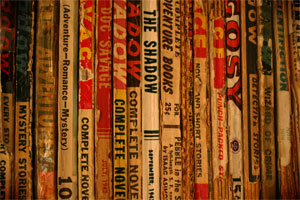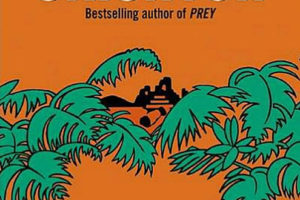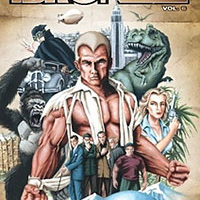What is (and is not) “pulp” is something that has generated a lot of discussion over the years.
 Some people are very stringent about what pulp is; others, not so much.
Some people are very stringent about what pulp is; others, not so much.
I can only offer my own view of what pulp is.
For me, there are different kinds of pulp. There is “original” or “classic” pulp. The real stuff. What was published in the pulp magazines that existed from the 1890s to the 1950s. Pulp magazines were so called because they were published on cheap, woodpulp paper. They were inexpensive, so pay rates were low, thus the writing was fast and furious.
Pulp magazines offered cheap reading for the masses in a highly literate society. But it’s not “bad” literature. Nor was is “lurid” or “sensationalist” as some try to claim.
And don’t think that the stories weren’t edited. Most were. We know that Lester Dent and Walter Gibson engaged in discussions with their editors on future Doc Savage and The Shadow stories before they wrote them, even needing to get pre-approval for future stories. They revised and left out stuff. And editors edited. They cut stuff, and rewrote stuff. Apparently the Thrilling editors did a lot of rewriting. Certainly the smaller and cheaper publishers didn’t do as much editing.
And don’t think that all pulp writers were hacks. Some were. But some used the pulp magazines as a springboard to better paying fields (“slick” magazines, books, other media like movies, radio, and even tv). Many succeeded. Others did not.
Most pulps were 7×10-inches in size. Some were larger, called “bedsheet”. For a period of time during World War II, several pulp magazines were reduced to digest size. Average page count ran from 128 to 192 pages, but some were as few as 64 pages and some as much as 320 pages. So the prices varied. 10 cents was the standard, but some were 5 cents, others as much as 25 cents.
The kinds of stories that existed in pulps ran the gamut. This is why we point out that pulp is a medium, not a genre. There were adventure, air, crime, detective, mystery, fantasy, horror, occult, railroad, romance, science fiction, sports, war, western. And there are sub-genres as well. Some genres were mainly found only in pulps, and not the slicks or more mainstream fiction magazines. Too often people think of only the hero pulps as the main genre, when there were others. Detective was big for many years, and romance was also big.
And to re-iterate, pulps were the popular fiction for the masses. As separted from the more literate fiction that appeared in the slicks and mainstream sources. Thus much of what appeared in the pulps, not just what was in the spicys or weird menace pulps, but also the romance, detective, science fiction, war, pulp heroes, etc could only have appeared in the pulps and no place else.
That is the real pulp.
But there were also the forerunners of pulp, the “proto pulp” if you will. The dime novels and story papers that came before the pulp magazines and sometimes had similar works. Here you found Nick Carter and many other larger-than-life detectives, scientific characters like Frank Reade Jr. and the like, western characters like Buffalo Bill and so forth. But what appeared in the dime novels is different from the pulps.
There are also media that popped up alongside pulp that could be “pulpish” or “pulp-like.” These are not pulp, but sometimes you saw pulp stories and characters make the transition to them. Media such as comic books (many pulp publishers also did comic books), radio, movies and movie serials. Thus you see Zorro (a pulp character) appear in comics and movie serials.
And then there are the media that popped up and replaced pulp: digests, paperback books, men’s adventure magazines (the ‘sweats’) and TV. Again, these are not pulp, but could be “pulpish” and “pulp-like.” Paperback books reprinted a lot of stuff from the pulps. Not just the various hero pulps (The Shadow, Doc Savage, etc.), but many writers who started off in pulps would get reprints of their works, or move to writing original works. So most science fiction, detective, westerns, and similar that were written before the 1950s that appeared later in paperback are most likely reprints from the pulps.
With the demise of pulps, most fiction magazines (especially science fiction and mystery) continued on in digest format. But most lost their pulpish aspects. The quality of the work improved. Others converted to men’s adventure and later lost a lot of the fiction for ‘true’ stories and articles.
I also feel that some genres that exist in the paperback medium are in some ways a continuation of pulp. The numbered men’s adventure series (The Executioner, The Destroyer, etc.) seem pulp-like. Thrillers and techno-thrillers seem pulp-like.
And keep in mind that a lot of pulp stories (hero pulps, but also western, mystery, and science fiction) were reprinted in paperback books. A lot of people have probably read pulp without realizing it because it appeared in more recently published books.
Personally, I think following pulp-like works in other media is something pulp fans should do. But don’t go for calling this “pulp.” It’s pulp-like or pulpish.
Then you have the “New Pulp” movement that has cropped up in recent years. I’ve never quite understood the animosity that some pulp fans have for New Pulp. Some turn their noses up at it. Some put it down as being only “fan fiction” or the like. (I’ve seen one person call it “self published,” which to me is a put-down, like saying someone isn’t legit enough to get a real publisher, such as going with a vanity publisher.) New Pulp aims for a similar sensabilitiy of the old pulps, but are certainly better written then the average pulp stories, and aren’t published on cheap pulp paper.
Sorry, but to me “fan fiction” is amateurish stuff passed among fans who see themselves as wannabe writers. Those doing New Pulp are professional writers, publishing through real publishers. Also, nobody gets paid for fan fiction. The New Pulp writers do get paid. Maybe not enough to make a living, but they get paid. Calling it “self published” is incorrect, even if the New Pulp publishers are using print-on-demand services to print their works. To give an example, Barry Reese is not “self published.” His work is edited and published by real publishers, who just happened to use POD.
I do agree with some that there seems to be an attitude to slap the word “pulp” on stuff that is not pulp, and it’s something I don’t care for. It reminds me somewhat of how people glommed onto the word “cyberpunk” and started variations of the term for different things (steampunk, dieselpunk, splatterpunk, ad nauseum), such that the original term and meaning was diluted. I see this too often on on-line forums when new people pop up with some comic book or fictional character and ask if its pulp, when the character is often two or three steps removed from pulp. And then they get upset when its pointed out they aren’t pulp or at most only a little bit pulp-like.
As noted, I prefer a broader view of pulp and pulp-like works. But I do have limits. For myself, I’ve found that Bill Thom‘s Pulp Coming Attractions pretty well matches my own views. I’ve rarely felt that something included there didn’t belong, or that something was left out.
So, what do others think? Add your comments or if you blog, put your thoughts there.
[REVISED]



I would like to think that even being self-published doesn’t automatically place you beyond the pale of legitimate New Pulp. I’m a professional writer with millions of words of fiction done for traditional publishers under my belt. But my eBook series THE IMPOSTOR (post-apocalyptic superhero stories) is both self-publsihed and written to the same standards as my other work.
The “problem” with self publishing is that the view of it is that you aren’t good enough to get a publisher (no matter how small) to publish your work, so you had to do it yourself. The implication is that you aren’t good enough. (and usually, the work isn’t too good or could be unpolished, needs editing, etc).
In the “old day”, you usually went to a vanity publisher (where you paid the publisher to publish you) or your printed up your work yourself and tried to sell it.
Now, with Print on Demand, its much easier to self-publish, good or bad. And some people put down small presses who use POD to do their printing, as if they are the same as self-publishing. And they are not.
And I think its important that those who try to form their own small press, which may publish their and other works, should NOT be viewed as the same thing as self-publishing.
If you are publishing your own stuff, I don’t see how it matters if you call yourself a “small press” operation or not. You are still self-publishing.
Again, there is a stigma about being self published.
If you self publish (or use a vanity press), the impression is that you might not have been good enough to get published by a “legit” publisher (whether a small press or large).
Self Published, Indy Published, Small Press, Mainstream Press are all headed to print on demand. All Ebooks are essentially print on demand as a copy is made for each buyer after they purchase it. I think the huge growth of independent publishers is mostly due to mainstream publishers not keeping up with reader demand.
Many writers are self publishing their back catalog of titles that they won the rights to, and adding titles that the big publishers don’t want. I don’t see the major publishers pushing out a lot of pulp style adventure fiction. I have self published in addition to being in books published by others. The readers will decide what succeeds.
Again, the point is that Print on Demand is just a method of printing, not publishing.
POD is used for self publishing, small press, large presses, etc.
Its a mistake to claim that POD == self publishing.
I agree with all the comments being said here. It’s true that a lot of fan fiction writers have now moved into small press publishing. Some have improved over the years, as experience will allow. I am a die-hard original pulp fan, and my problem is with those who take original characters and change them to so-called modern sensibilities. Many have no idea what the real characters were. But I am all for the printing technology we see today, where new writers can publish their creativity in POD. Like several comments, I know many professional writers who have moved away from the Big 6, and are publishing their own books. They are getting fed up with the big publishing houses and striking out on their on. Go far it! But Laurie is right on about what pulp is, and what pulp isn’t. Comic books are a visual media, television and movies are their own media, radio is a media, leave pulps where they belong. I write a lot of pulp-like stories myself, and wish the pulps were still around. But their day ended. Now it’s paperbacks, hardbacks, POD, and eBooks. Life goes on.
Good points.
Agree on the matter of changing original characters for “modern sensibilities”. Am totally apposed to that. I will accept some tweaks and improvements if its in line with the original character. For instance, I think Barry Reese has done a good job of improving Doctor Satan.
I agree, there are several new writers doing a great job. Some of Ron Fortiers writers are turning out some great stuff. I can’t comment on Berry Reese, as I’ve never read any of his work. But New Pulp writers are carrying the pulp tradition forward, and we should all be proud of that.
Also, Tom, you are a writer AND in that group of those who care about pulps and the new stories and getting them back in the public view –
A. Sippo, C. Welch, E. Hulse, M. Moring, C. P. Carey, W. S. Eckert and yourself and W. Murray and others who work on conventions & gatherings and publishing these stories. Thanks for that!
I wonder if this is a change for the future of all publishing – that Kickstarter projects – print-on-demand and self-publishing is gaining momentum. (Also you, Tom, are a writer AND among that group of those who bring pulps and discussion of the newer fiction back to the public view — W. Murray, A. Sippo, C. P. Carey, M. Moring, C. Welch, B. Reese, and yourself and others. Thanks for that!)
I’ve seen some cases of authors starting out publishing their own works until the established publishers pick them up and publish them.
Also, POD allows for small presses to be able to compete with the big boys and put out books of comparable quality, and be able to avoid tying up money in unsold stock, and have others handle shipping.
Allowing authors to keep their works in print when the big boys drop their earlier works is also great.